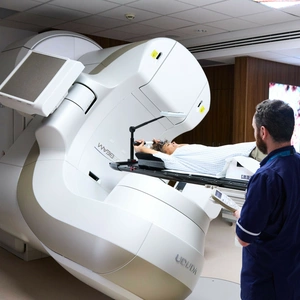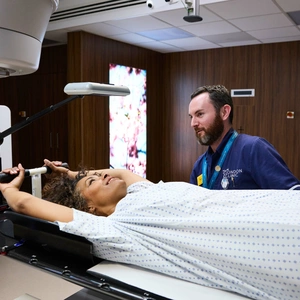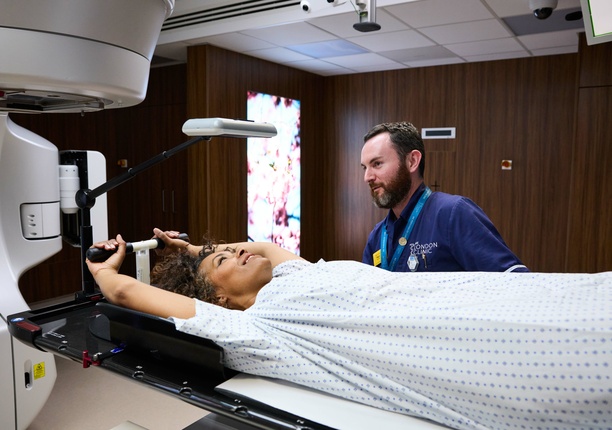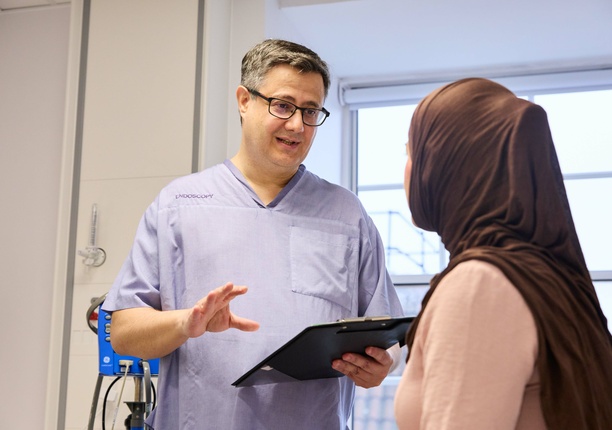Stereotactic radiotherapy
Stereotactic radiotherapy is a highly targeted form of radiotherapy, delivered with fewer treatment fractions than conventional radiotherapy.
At The London Clinic Lung Centre, we work with a team of world-class consultants and radiotherapists. Our specialists are experts at developing personalised treatment plans that maximise the benefits of stereotactic radiotherapy.
Stereotactic radiotherapy FAQs
While the side effects of stereotactic radiotherapy for lung cancer are less common than with conventional radiotherapy, you may still experience some. If you are affected by side effects following treatment, they tend to develop days, weeks or even months after treatment.
Possible side effects include:
- Soreness and swelling in the treated area
- Fatigue
- Red, dry or itchy skin
- Coughing and shortness of breath
Compared to standard radiotherapy and surgery, the benefits of stereotactic radiotherapy include:
- Fewer side effects
- Minimal recovery
- Fewer treatment sessions
At The London Clinic Lung Centre, we use state-of-the-art equipment to deliver highly precise stereotactic radiotherapy. We have two machines which can be used to deliver treatment, the RapidArc (which uses a linear accelerator to deliver highly-targeted radiation as it rotates around the patient in a 360-degree arc) and the CyberKnife platform – the first and only fully robotic radiotherapy device.
These systems deliver beams of radiation from various angles while you are lying on a treatment couch. As you breathe or move during treatment, your tumour may shift position. Both of these machines monitor your movements and adjust their radiation beams to deliver precise treatment.
Step 1: Preparing for stereotactic radiotherapy
Before your stereotactic body radiotherapy, you will undergo a computed tomography (CT) scan to create a detailed image of your lungs. Depending on your case, your specialist may also recommend a magnetic resonance imaging (MRI) scan or positron emission tomography (PET) scan to gather additional information.
These images will enable your consultant to pinpoint exactly where the radiation needs to hit to treat the tumour and reduce damage to the surrounding healthy tissue.
Your consultant may also create a mask or mould to help you stay in the correct position during your treatment. Alternatively, small metal markers may be placed near your tumour, and tiny markings may be made on your skin to help guide the radiation.
On the day of your treatment, you will need to wear loose, comfortable clothing without any metal items (for example, buttons or zips) and remove any jewellery. Your care team will review your medical history and discuss any conditions you have, including whether you are or could be pregnant.
Step 2: During stereotactic radiotherapy
To begin the treatment, you will lie on a radiotherapy couch, and your care team will apply any moulds or markers needed to guide the radiation. They will help to make you comfortable so that you can stay as still as possible throughout the treatment.
Once you are in the right position, the radiographers will leave the room. They will be able to see and hear you at all times and can communicate with you via intercom.
You won’t feel anything during the treatment. It usually takes 30–60 minutes, and you’ll be able to go home on the same day.
Once the treatment is complete, your radiographers will re-enter the room and help you get down from the treatment couch.
Step 3: Recovery and aftercare
After each treatment session, you will be able to go straight home and should be able to resume normal activities within one to two days. You will not be radioactive after the treatment, so it will be safe to be around other people straight away.
Your care team may advise you to use a moisturiser on the treated area and to wear loose-fitting clothing to avoid rubbing.
Between each treatment session, you will have regular reviews with your care team. These will assess whether you are experiencing any side effects and how well the treatment is working.
Once you have completed your full course of treatment, you will have a follow-up appointment with your consultant to ensure your recovery is progressing as expected.






